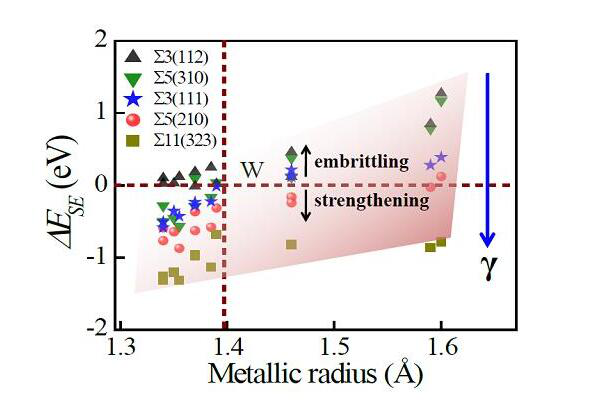
Control of segregation-induced grain boundary (GB) strengthening is a strategy to improve the ductility and intergranular fracture of metals. Tungsten (W) is considered as the primary candidate material for plasma-facing components in future fusion reactors because of its excellent physical and chemical properties.
However, W also exhibits serious irradiation induced brittleness which occurs mostly by intergranular fracture associated with weak GBs. Therefore, understanding and controlling the properties of W materials at GB regions is highly valued, especially for the effect of impurities on the GB strength. It is worth noticing that the segregation of solutes and their impact on GB cohesion should be related to the GB structures the solute itself. But the dependence is poorly understood by now.
Recently, in order to reveal the dependence of segregation-induced GB strengthening on the GB structures and the radius of solute itself, a research team led by Prof. LIU Changsong in Institute of Solid State Physics, Hefei Institutes of Physical Sciences of the Chinese Academy of Sciences achieved an important progress on the GB strengthening mechanism in tungsten by solute decoration.
In their work, based on first-principles calculations, they found that the GB strengthening depends strongly on the GB structures. The solutes tend to enhance cohesion for GBs with larger GB energies, while they decreased cohesion forthose with smaller GB energies.
In addition, it was found that for all GBs the strengthening energies of elements correlate positively with their metallic radii, implying that the size effect plays a major role in the GB strengthening in W.
Besides, by analyzing the strengthening effect of solutes at different segregated sites, they found that the oversized solutes (Zr, Nb, Hf, Ta) act as cohesion enhancers when segregated in the GB plane, while the undersized elements (Ru, Rh, Re, Os, Ir) strengthen the GBs at the nearest neighbor positions.
Their work reveals how the GB structures and the metallic radius of solute affect the GB strength in W and uncover the mechanism.
Furthermore, the increase of GB strength by Re/Ta/Zr impurity provides a good explanation for why these elements lead to an improved intergranular fracture experimentally. The obtained database of grain boundary strengthening also presents a theoretical guide in the experimental search for promising W alloying elements to increase the fracture resistance.
The results were published in Acta Materialia entitled First-principles determination of grain boundary strengthening in tungsten: dependence on grain boundary structure and metallic radius of solute.
The research was sponsored by the National Magnetic Confinement Fusion Energy Research Program, the National Natural Science Foundation of China and the Youth Innovation Promotion Association of Chinese Academy of Sciences.

Dependence of ΔESEon the metallic radii of solutes at their most favorable positions forΣ3(112),Σ5(310), Σ3(111), Σ5(210) and Σ11(332) GBs in order of increasing the GB energy γ. (Image by WU Xuebang)

86-10-68597521 (day)
86-10-68597289 (night)

52 Sanlihe Rd., Xicheng District,
Beijing, China (100864)

